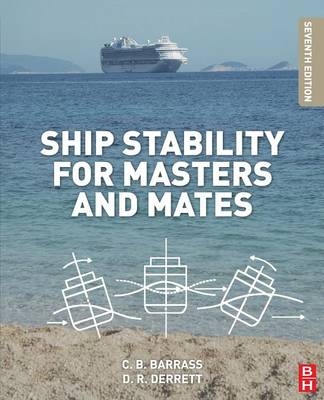
Ship Stability for Masters and Mates
Butterworth-Heinemann Ltd (Verlag)
978-0-08-097093-6 (ISBN)
Ship Stability for Masters and Mates explores all aspects of ship stability and ship strength, squat, and interaction and trim, as well as materials stresses and forces. Organized into 56 chapters, the book looks at the relationship between ship stability and ship motion, with emphasis on group weights in a ship. It also explains how TPCs are calculated for a range of drafts extending beyond the light and loaded drafts, along with form coefficients, including the coefficient of fineness of the waterplane area.The book explains how to perform KB, BM, and KM calculations and make graphics on metacentric diagrams. It considers large-angle stability, the effect of beam and freeboard on stability, and hydrostatic curves and values for vessels that are initially on even keel. The reader is also introduced to free-surface effects of slack tanks with divisional bulkheads, how side winds affect ship stability, and the correlation between freeboard and stability curves. Other chapters focus on timber ship freeboard marks, procedures and calculations for drydocking and stability, and ship squat in open water and in confined channels. The book also includes extracts from the 1998 Merchant Shipping (Load Line) Regulations Number MSN 1752(M).This book is intended for students seeking to obtain Transport Certificates of Competency for Deck Officers and Engineering Officers and STCW equivalent International qualifications, as well as Chief Mates and Officers on Watch (Officers in Charge) on board merchant ships and other maritime personnel, port authorities, marine consultants, nautical study lecturers, and marine superintendents.
Dr Bryan Barrass worked as a Ship Draughtsman for 11 years at Swan Hunters Shipyard in Wallsend. In 1963, he then became a Lecturer in Naval Architecture in Sunderland. From 1967 to 1993, he worked at Liverpool John Moores University, lecturing to Maritime Degree students, Masters, Mates, and Marine Engineers. In 1993 he retired from full-time work. He became a visiting Lecturer and has written seven books involving Ship Stability, Ship Design & Ship Performance and Ship Squat & Interaction. His interest in Ship Squat began in April 1972, starting on research for his Ph.D. degree. He has worked with many national & international Port Authorities. They include the PLA, Milford Haven PA, Liverpool PA, Humberside PA, Tyne PA, Truro PA, Newhaven PA, Bordeaux PA, Klaipeda PA, Nantes PA and Hamburg PA. Dr Barrass has supplied Ship Squat and Interaction information to 22 countries worldwide. He has lectured at a great number of UK Universities and has advised many Ship-owners on the above listed Specialist topics.
Preface; Introduction; Group Weights, Water Draft, Air Draft, and Density; Transverse Statical Stability; Effect of Decreasing Free Surface on Stability; TPC and Displacement Curves; Form Coefficients; Discussion on LCB Position Relative to Amidships; Quadrature- Simpson’s Rules for Areas and Centroids; Quadrature- Simpson’s Rules for Moments of Inertia; Quadrature- Simpson’s Rules for Centers of Pressure on Transverse Bulkheads; KB, BM, and KM Calculations and Graphics on Metacentric Diagrams; Final KG Plus 20 Reasons for Rise in KG; Angle of List Considerations- Text, Calculations, and Graphics; Angle of Heel- Effects of Suspended Weights; Angle of List Due to Bilging of Side Compartments; Heel Due to Turning; Angle of Loll; Moments of Statical Stability; Aspects of Trim- The Main Factors Involved; Trim Calculations- Changing Conditions of Loading; Trim Calculations- Satisfying Prescribed Requirements for End Drafts; Large-Angle Stability Considerations e GZ and KN Cross Curves of Stability; Effects of Beam and Freeboard on Large Angle Stability; Dynamical Stability Relating to Statical Stability Curves; Changes in Statical Stability Relating to Wave Profiles- Loss of Quasi-Static Stability; Hydrostatic Curves and Values for Vessels Initially on Even Keel; Hydrostatic Curves and Values for Vessels Initially Having Trim by the Bow or by the Stern; Increase in Draft Due to List; Combined List and Trim; Calculating Free-Surface Effects of Slack Tanks with Divisional Bulkheads; Bilging Effects of Stability- Permeability Effects; Effects of Side Winds on Ship Stability; Icing Allowances Plus Effects on Trim and Stability; The Sectional Area Curve; FL and PL Curves Plus Type A and Type B Vessels; Load Lines and Freeboard Marks; Timber Ship Freeboard Marks; IMO Grain Rules for Safe Carriage of Grain in Bulk; True Mean Draft; Inclining Experiment (Stability Test) Plus Fluctuations in a Ship’s Lightweight; The Calibration Book Plus Soundings and Ullages; Drydocking and Stability- Procedures and Calculations; Ship Squat in Open Water and in Confined Channels; Turning Circle Diameter (TCD) Values for Vessels in Shallow Waters; Interaction Effects, Including Two Case Studies; Rolling, Pitching, and Heaving Motions; Synchronous Rolling and Parametric Rolling of Ships; Effects of Change of Density on a Ship’s Draft and Trim; The Deadweight Scale; The Trim and Stability Book; Simplified Stability Information; The Stability Pro-Forma; Looking Forward into the Next Decade; Draft Surveys; Quality Control- Plus the Work of Ship Surveyors; Extracts from the 1998 Merchant Shipping (Load Line) Regulations Number MSN 1752(M); Keeping Up to Date; Appendix I: Summary of Stability Formulae; Appendix II: SQA/MCA 2004 Syllabuses for Masters and Mates; Appendix III: Specimen Exam Questions with Marking Scheme; Appendix IV: 100 Revision One-Liners; Appendix V: How to Pass Exams in Maritime Studies; Appendix VI: Ship Stability Data Sheets; Appendix VII: Capsize of the Herald of Free Enterprise- A Journalistic Review; References; Answers to Exercises; General Particulars of Selected Merchant Ships, Delivered 2007-2011; Nomenclature of Ship Terms; Index
| Erscheint lt. Verlag | 5.9.2012 |
|---|---|
| Verlagsort | Oxford |
| Sprache | englisch |
| Maße | 191 x 235 mm |
| Gewicht | 1440 g |
| Themenwelt | Technik ► Fahrzeugbau / Schiffbau |
| Technik ► Maschinenbau | |
| ISBN-10 | 0-08-097093-1 / 0080970931 |
| ISBN-13 | 978-0-08-097093-6 / 9780080970936 |
| Zustand | Neuware |
| Haben Sie eine Frage zum Produkt? |
aus dem Bereich


